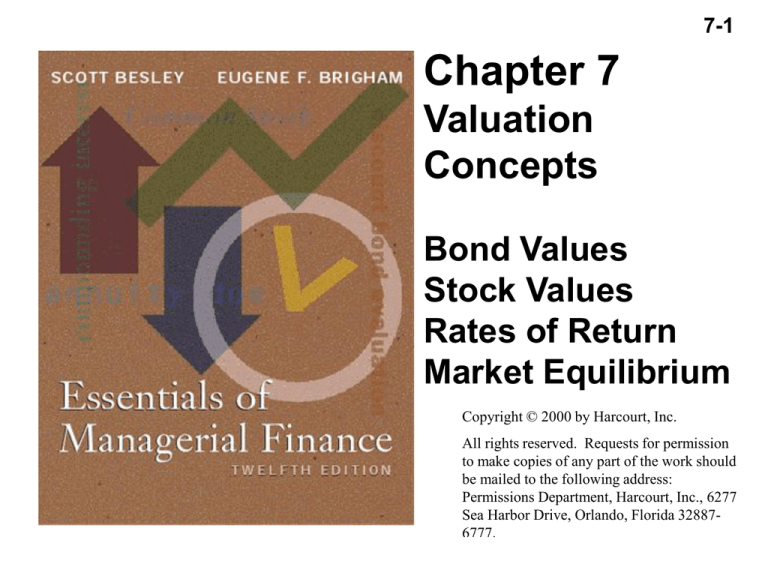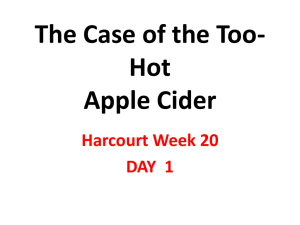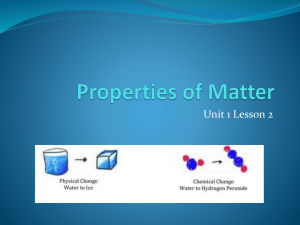
7-1
Chapter 7
Valuation
Concepts
Bond Values
Stock Values
Rates of Return
Market Equilibrium
Copyright © 2000 by Harcourt, Inc.
All rights reserved. Requests for permission
to make copies of any part of the work should
be mailed to the following address:
Permissions Department, Harcourt, Inc., 6277
Sea Harbor Drive, Orlando, Florida 328876777.
Copyright (C) 2000 by Harcourt, Inc. All rights
reserved.
7-2
Basic Valuation
From “The Time Value of Money”
we realize that the value of
anything is based on the present
value of the cash flows the asset is
expected to produce in the future.
Copyright (C) 2000 by Harcourt, Inc. All rights
reserved.
7-3
Basic Valuation
^
^
Asset
CF
CF
1
2
V
1
2
value
1 k 1 k
N
^
CF
1 k
t 1
^
CF
N
1 k
N
^
CF = the cash flow expected to
t
t
t
be generated by the asset in
period t
k = the return investors consider appropriate for
holding such an asset - usually referred to as the
required return, based on riskiness and economic
Copyright (C) 2000 by Harcourt, Inc. All rights
conditions
reserved.
7-4
Valuation of Financial Assets:
Bonds - long term debt instruments
Key Terms
Principal Amount, Face Value, Maturity
Value, Par Value: The amount of money
the firm borrows and promises to repay at
some future date, often at maturity.
Coupon Payment: The specified number
of dollars of interest paid each period,
generally each six months, on a bond.
Copyright (C) 2000 by Harcourt, Inc. All rights
reserved.
7-5
Key Terms
Coupon Interest Rate: The stated annual
rate of interest paid on a bond.
Maturity Date: A specified date on which
the par value of a bond must be repaid.
Original Maturity: The number of years
to maturity at the time the bond is issued.
Call Provision: Gives the issuer right to
pay off bonds prior to maturity.
Copyright (C) 2000 by Harcourt, Inc. All rights
reserved.
7-6
The Basic Bond
Valuation Model
kd = required rate of return on a debt
instrument
N = number of years before the bond
matures
INT = dollars of interest paid each year
(Coupon rate x Par value)
M = par or face, value of the bond to be
paid off at maturity
Copyright (C) 2000 by Harcourt, Inc. All rights
reserved.
7-7
Bond Value
V
d
INT
INT
1 k d 1 1 k d 2
...
INT
M
N
t
1 k
1 k
d
d
t 1
INT(PVIFA
k ,N
d
INT
M
1 k d N 1 k d N
) M(PVIF
k ,N
d
)
Copyright (C) 2000 by Harcourt, Inc. All rights
reserved.
7-8
Genesco 15%, 15year,
$1,000 bonds valued at
15% required rate of return
Numerical solution:
Bond
value
1
1 1 . 15 15
$ 150
0 . 15
1
$ 1, 000
1.15
15
Vd = $150 (5.8474) + $1,000 (0.1229)
= $877.11 + $122.89 = $1,000
Copyright (C) 2000 by Harcourt, Inc. All rights
reserved.
7-9
Genesco 15%, 15year,
$1,000 bonds valued at
15% required rate of return
Tabular solution:
Look up the PVIF and PVIFA values in
Tables A-1 and A-2 and insert them in
the equation
Vd = $150 (5.8474) + $1,000 (0.1229)
= $877.11 + $122.89 = $1,000
Copyright (C) 2000 by Harcourt, Inc. All rights
reserved.
7-10
Genesco 15%, 15year,
$1,000 bonds valued at
15% required rate of return
Financial calculator solution:
INPUTS
OUTPUT
15
N
15
I/YR
PV
- 1000
150
PMT
1000
FV
Copyright (C) 2000 by Harcourt, Inc. All rights
reserved.
7-11
Changes in Bond Values
Over Time
If the market rate associated with a bond, kd,
equals the coupon rate of interest, the bond
will sell at its par value.
If interest rates in the economy fall after the
bonds are issued, kd is below the coupon rate.
The interest payments and maturity payoff stay
the same, but the PVIF and PVIFA values are
based on the new kd increasing the bond value
Copyright (C) 2000 by Harcourt, Inc. All rights
reserved.
7-12
Changes in Bond Values
Over Time
Current
yield
INT
Vd
Current yield is the annual
interest payment on a bond
divided by its current market
value
Beginning
Ending
Capital bond value bond value
gains yield
Beginning
bond value
V d, End V d, Begin
V d, Begin
Copyright (C) 2000 by Harcourt, Inc. All rights
reserved.
7-13
Changes in Bond Values
Over Time
Discount Bond
A bond that sells below its par value, which
occurs whenever the going rate of interest
rises above the coupon rate
Premium Bond
A bond that sells above its par value, which
occurs whenever the going rate of interest
falls below the coupon rate
Copyright (C) 2000 by Harcourt, Inc. All rights
reserved.
7-14
Changes in Bond Values
Over Time
An increase in interest rates will cause the
price of an outstanding bond to fall
A decrease in interest rates will cause the
price to rise
The market value of a bond will always
approach its par value as its maturity
date approaches, provided the firm
does not go bankrupt
Copyright (C) 2000 by Harcourt, Inc. All rights
reserved.
7-15
Time path of value of a 15% Coupon,
$1000 par value bond Year k = 10%
d
when interest rates
0
$1,380.30
are 10%, 15%,
1
$1,368.33
2
$1,355.17
and 20%
3
4
5
6
7
8
9
10
11
12
13
14
15
$1,340.68
$1,324.75
$1,307.23
$1,287.95
$1,266.75
$1,243.42
$1,217.76
$1,189.54
$1,158.49
$1,124.34
$1,086.78
$1,045.45
$1,000.00
k d = 15% k d = 20%
$1,000.00
$766.23
$1,000.00
$769.47
$1,000.00
$773.37
$1,000.00
$778.04
$1,000.00
$783.65
$1,000.00
$790.38
$1,000.00
$798.45
$1,000.00
$808.14
$1,000.00
$819.77
$1,000.00
$833.72
$1,000.00
$850.47
$1,000.00
$870.56
$1,000.00
$894.68
$1,000.00
$923.61
$1,000.00
$958.33
$1,000.00 $1,000.00
Copyright (C) 2000 by Harcourt, Inc. All rights
reserved.
7-16
Changes in Bond Values
Over Time
Time path of value of a 15% Coupon, $1000 par value
bond when interest rates are 10%, 15%, and 20%
Bond Value
$1,500
Kd < Coupon Rate
$1,250
Kd = Coupon Rate
$1,000
$750
Kd > Coupon Rate
$500
$250
$0
1
3
5
7
9
11
13
15
Years
Copyright (C) 2000 by Harcourt, Inc. All rights
reserved.
7-17
Finding the Interest Rate on a Bond:
Yield to Maturity
YTM is the average rate of return earned on a bond
if it is held to maturity Annual
Accrued
interest
capital gains
Approximate
yield to maturity
Average value of bond
(does not consider time
value of money)
M - Vd
INT
N
2 Vd M
3
Copyright (C) 2000 by Harcourt, Inc. All rights
reserved.
7-18
Bond Values with
Semiannual Compounding
INT
2N
Vd
t 1
2
kd
1
2
t
INT
PVIFA
2
M
kd
1
2
kd
2
,2N
2N
M PVIF
kd
2
,2N
Copyright (C) 2000 by Harcourt, Inc. All rights
reserved.
7-19
Interest Rate Risk on a Bond
Interest Rate Price Risk - the risk of
changes in bond prices to which
investors are exposed due to changing
interest rates
Interest Rate Reinvestment Rate Risk the risk that income from a bond
portfolio will vary because cash flows
have to be reinvested at current market
rates
Copyright (C) 2000 by Harcourt, Inc. All rights
reserved.
7-20
Value of Long and Short-Term
15% Annual Coupon Rate Bonds
Value of
Current Market
Interest Rate, k
1-Year Bond
14-Y ear Bond
d
5%
$
1,095.24
$
1,989.86
10%
15%
20%
25%
$
$
$
$
1,045.45
1,000.00
958.33
920.00
$
$
$
$
1,368.33
1,000.00
769.47
617.59
Copyright (C) 2000 by Harcourt, Inc. All rights
reserved.
7-21
Value of Long and Short-Term
15% Annual Coupon Rate Bonds
Bond
Value
($) 2,000
14-Year Bond
1,500
1,000
1-Year Bond
500
0
5
10
15
20
25
Interest Rate, k d (%)
Copyright (C) 2000 by Harcourt, Inc. All rights
reserved.
7-22
Bond Prices in Recent Years
Copyright (C) 2000 by Harcourt, Inc. All rights
reserved.
7-23
Valuation of Financial Assets Equity (Stock)
Common Stock
Preferred Stock
– hybrid
• similar to bonds with fixed
dividend amounts
• similar to common stock as
dividends are not required and
have no fixed maturity date
Copyright (C) 2000 by Harcourt, Inc. All rights
reserved.
7-24
Stock Valuation Models
Terms: Expected Dividends
Dˆ t dividend
the stockholde
r expects to
recieve at the end of Year t
D 0 is the most recent dividend
Dˆ 1 is the next dividend
and it will
expected
to be paid,
be paid at the end of this year
Dˆ 2 is the dividend
All future dividends
estimates
already paid
expected
at the end of two years
are expected
values, so the
may differ among investors
Copyright (C) 2000 by Harcourt, Inc. All rights
reserved.
7-25
Stock Valuation Models
Terms: Market Price
P0 the price at which
a stock
sells in the market tod ay
Copyright (C) 2000 by Harcourt, Inc. All rights
reserved.
7-26
Stock Valuation Models
Terms: Intrinsic Value
Pˆ 0 the value of an asset that , in the
mind of an investor,
is justified
by the facts and may be different
from the asset' s current market
price, its book value
, or both
Copyright (C) 2000 by Harcourt, Inc. All rights
reserved.
7-27
Stock Valuation Models
Terms: Expected Price
Pˆ t the expected
price of the stock
at the end of each Year t
Copyright (C) 2000 by Harcourt, Inc. All rights
reserved.
7-28
Stock Valuation Models
Terms: Growth Rate
g the expected
in dividends
rate of change
per share
Copyright (C) 2000 by Harcourt, Inc. All rights
reserved.
7-29
Stock Valuation Models
Terms: Required Rate of Return
k s the minimum
rate of return on a
common
stock that
stockholde
consider
acceptable
given its
riskiness
and returns available
other investment
rs
on
s
Copyright (C) 2000 by Harcourt, Inc. All rights
reserved.
7-30
Stock Valuation Models
Terms: Dividend Yield
ˆ
D
1
P0
the expected
dividend
divided
by the current price of a share
of stock
Copyright (C) 2000 by Harcourt, Inc. All rights
reserved.
7-31
Stock Valuation Models
Terms: Capital Gain Yield
P1 P0
the change in price (capital gain)
P0
during a given year divided
price at the beginning
by its
of the year
Copyright (C) 2000 by Harcourt, Inc. All rights
reserved.
7-32
Stock Valuation Models
Terms: Expected Rate of Return
ˆk the rate of return on a common
s
stock that an individual investor
expects to receive;
equal to the
expected dividend yield plus the
expected capital gains yield
Copyright (C) 2000 by Harcourt, Inc. All rights
reserved.
7-33
Stock Valuation Models
Terms: Actual Rate of Return
k s the rate of return on a common
stock that
actually
an individual
receives,
investor
after the
equal to the dividend
fact;
yield plus
the capital gains yield
Copyright (C) 2000 by Harcourt, Inc. All rights
reserved.
7-34
Expected Dividends as
the Basis for Stock Values
If you hold a stock forever, all you
receive is the dividend payments
The value of the stock today is the
present value of the future dividend
payments
Copyright (C) 2000 by Harcourt, Inc. All rights
reserved.
7-35
Expected Dividends as
the Basis for Stock Values
V s Pˆ 0 PV of expected future dividends
Value of Stock
ˆ
D
1
1 k s
1
t 1
ˆ
D
2
1 k s
2
ˆ
D
1
ks
ˆ
D
t
1 k s
t
Copyright (C) 2000 by Harcourt, Inc. All rights
reserved.
7-36
Stock Values with Zero Growth
A Zero Growth Stock is a common stock
whose future dividends are not expected
to grow at all
ˆ D
ˆ ... D
ˆ D
g 0, and D
2
0
1
Pˆ 0
D
1 k s
1
D
1 k s
2
...
D
1 k s
Copyright (C) 2000 by Harcourt, Inc. All rights
reserved.
7-37
Normal, or Constant, Growth
Growth that is expected to continue into
the foreseeable future at about the same
rate as that of the economy as a whole
g = a constant
Copyright (C) 2000 by Harcourt, Inc. All rights
reserved.
7-38
Normal, or Constant, Growth
(Gordon Model)
D 0 1 g
1
Pˆ 0
1
1 k s
D 0 1 g
ks g
D 0 1 g
2
1
2
ks
D 0 1 g
1
ks
ˆ
D
1
ks g
Copyright (C) 2000 by Harcourt, Inc. All rights
reserved.
7-39
Expected Rate of Return on a
Constant Growth Stock
Dividend yield
Expected growth rate, or capital gains yield
ˆk
s
ˆ
D1
P0
g
Copyright (C) 2000 by Harcourt, Inc. All rights
reserved.
7-40
Valuing Stocks with
Nonconstant Growth
Nonconstant Growth: The part of the life
cycle of a firm in which its growth is
either much faster or much slower than
that of the economy as a whole
Copyright (C) 2000 by Harcourt, Inc. All rights
reserved.
7-41
Valuing Stocks with
Nonconstant Growth
1. Compute the value of the dividends that
experience nonconstant growth, and then
find the PV of these dividends
2. Find the price of the stock at the end of the
nonconstant growth period, at which it has
become a constant growth stock, and
discount this price back to the present
3. Add these two components to find the
intrinsic value of the stock, Pˆ .
0
Copyright (C) 2000 by Harcourt, Inc. All rights
reserved.
7-42
Stock Market Equilibrium
1. The expected rate of return as seen by
the marginal investor must equal the
required rate of return, k
^ =k ,
x
x
2. The actual market price of the stock
must equal its intrinsic value as estimated
by the marginal investor, P ^
P
0 =
0
Copyright (C) 2000 by Harcourt, Inc. All rights
reserved.
7-43
Changes in Stock Prices
Investors change the rates of return
required to invest in stocks
Expectations about the cash flows
associated with stocks change
Copyright (C) 2000 by Harcourt, Inc. All rights
reserved.
7-44
The Efficient Markets Hypothesis
The weak form of the EMH states that all
information contained in the past price
movements is fully reflected in current market
prices.
The semistrong form states that current market
prices reflect all publicly available information
The strong form states that current market
prices reflect all pertinent information, whether
publicly available or privately held.
Copyright (C) 2000 by Harcourt, Inc. All rights
reserved.
7-45
Valuation of Real
(Tangible) Assets
A company proposes to buy a machine so it
can manufacture a new product. After five
years the machine will be worthless, but
during the five years it is used, the company
will be able to increase its net cash flows by
the following amounts:
Copyright (C) 2000 by Harcourt, Inc. All rights
reserved.
7-46
Valuation of Real
(Tangible) Assets
Year
1
2
3
4
5
Expected Cash Flow, CF
$120,000
$100,000
$150,000
$80,000
$50,000
To earn a 14% return on investments like this,
what is the value of this machine?
Copyright (C) 2000 by Harcourt, Inc. All rights
reserved.
7-47
Cash Flow Time Lines
0
14%
1
$120,000
2
3
4
5
$100,000
$150,000
$80,000
$50,000
PV of $120,000
PV of $100,000
PV of $150,000
PV of $80,000
PF of $50,000
Asset Value =V0
$ 120 , 000
1 . 14
1
$ 100 , 000
1 . 14
2
$ 150 , 000
1 . 14
3
$ 80 , 000
1 . 14
4
$ 50 , 000
1 . 14
5
Copyright (C) 2000 by Harcourt, Inc. All rights
reserved.
7-48
End of Chapter 7
Valuation Concepts
Copyright (C) 2000 by Harcourt, Inc. All rights
reserved.







